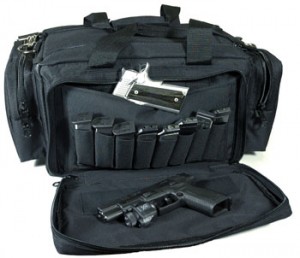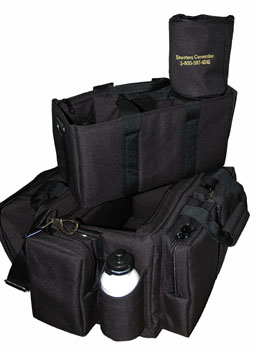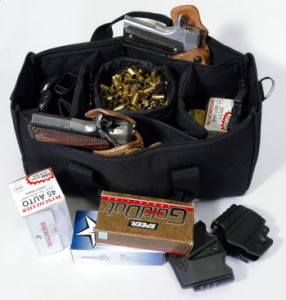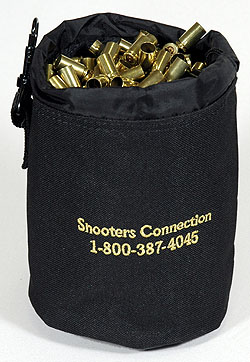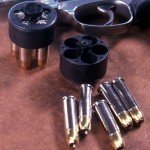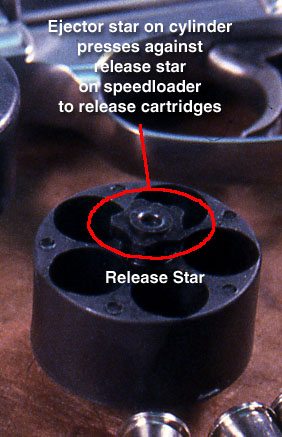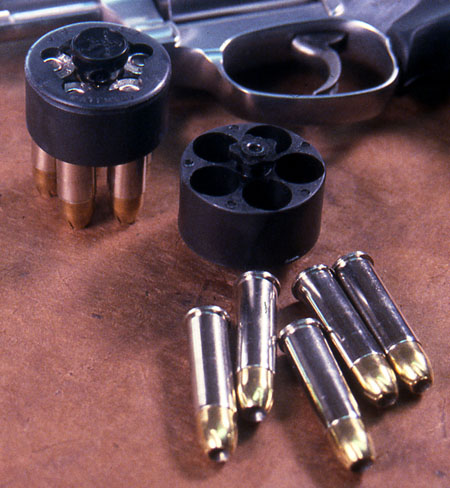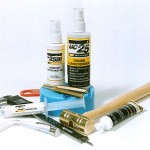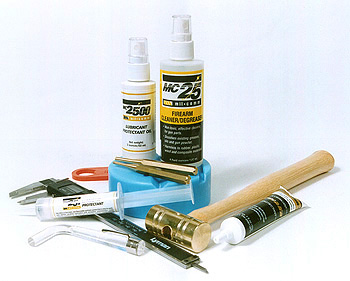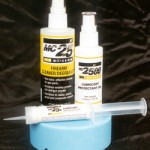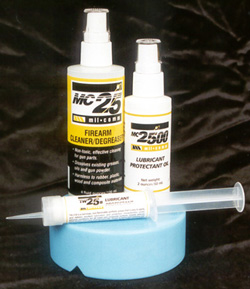By Tony “TRB” Phillips
Over the past… three or four years, mounting flashlights to weapons has become a very in-vogue thing to do. Sub-machine gun and shotgun mounts have been popular with entry teams for years, and for good reason. A large percentage of gunfights occur at night, and a dimly lit crack house can be every bit as dark as night even at high noon. Thusly, the need for the light is established. Working against that need is the difficulty encountered in manipulating a flashlight while using a two-handed shoulder weapon. It can be done… the M-16 is very flashlight friendly, for example. One can sandwich a Sure-Fire between their hand and the hand guard, and pull the light back against the magwell to illuminate. However, many weapons, most notably shotguns, aren’t so kind. To meet this need, SureFire has long been leading the way in replacement forends that allow one to seamlessly integrate a flashlight into a weapon. They’ve also developed shock-isolation techniques that allow the lamp modules to survive the vibrations of recoil and exposure to muzzle blast. Also, SureFire, along with many other companies, have marketed a number of cruder, but equally effective clamp-on mounts. The “Picatinny Rail Renaissance” of recent years has brought forth a new form of light, ably represented by Insight Technologies’ M series, and SureFire’s Millennium WeaponLights, that mount directly to rails.
Throughout all of this, the handgun was mostly ignored. SureFire did find a niche market for a clamp-on housing for several of the more popular handgun designs. Predating the earliest railed handguns by a number of years, this mount, still in production as the Classic Series, has had very little exposure in the gun press, despite being in use by LAPD SWAT on their 1911A1 sidearms. In spite of this, the handgun was still thought to be best served by the separately carried, handheld light, deployed with the weapon using various alignment techniques such as the well-known Harries technique, or, if the flashlight design accommodated it, the SureFire method. There were problems, though. One was the fact that without a great deal of training, it was difficult to use the handgun as proficiently with the light as it was without it. There were also difficulties encountered in keeping the light’s beam “indexed” to the weapon’s sights. It was finally determined that these difficulties could be addressed by mounting the light to the weapon.
While Sure-Fire’s older housings were available and effective, inspiration was found in the US SOCOM MK23 pistol: add a rail to the pistol’s dust cover, and mount a small but powerful flashlight directly to the weapon, in line with the muzzle. Glock was one of the first manufacturers to capitalize on this, reengineering the frames of the entire line, with the exception of the sub-compacts, to accept a light. This trend has continued, unabated, ever since, and even now manufacturers are going out of their way to incorporate the light rail into new and existing designs. Beretta has finally jumped on the bandwagon, after a long delay, with the 92/96 Vertec, and even the M1911 is represented, by Springfield Armory’s Operator. The Operator is not the first 1911 to utilize the rail mounted light, though. The late, great, pistolsmith Brian Bilby was one of the first to fabricate a Picatinny rail, and, at the customer’s request, weld it to the dust cover of a stock 1911. This gave any 1911 owner the ability to mount an M3 light, or a SureFire Millennium, to their pistol.
Unfortunately, unlike the newer pistols which have always had rails, or on which the addition of rails didn’t change their shape, adding a rail to the 1911 severely limits one’s holster selection. The only major manufacturers putting full length dust cover rails on their pistols are Springfield and STI; Wilson has jumped on the short rail, which is now an option on the CQB. Even at this, though, there still hasn’t been enough interest for there to be high quality holsters developed for the railed 1911.
When I was becoming interested in mounting a light on my .45, all this went through my mind, over and over. How to get around it? I knew that, sadly, I’d have to give up on quick detachability. I didn’t want to give up all hope of using my favored holsters, though, those being the Milt Sparks IWB and the Safariland 6004. I found the answer in the old guard of handgun mounted lights. The SureFire Classic Series.
The SureFire Classic is the only gunsmithing-free way to mount a light to a number of weapons, most notably the Browning Hi-Power and the M1911. It also remains the most expedient way to mount a light to many pistols in the Sig-Sauer line, as well as the Beretta 92 family, pre-Vertec. I recently purchased one for evaluation and use both on my respected Colt 1991A1, EF1, veteran of some 15,000 rounds of practice and combat competition, and her successor, the highly refined, hand-built CSA Special, the Black .45, EF2. The 610R Classic Series WeaponLight consists of an H10R switch housing, an L60 lamp assembly, consisting of the shock isolated bezel, the midsection which shares battery housing duties with the switch body, and a standard SureFire P60 lamp, producing 65 lumens of light with a runtime of one hour. The system is also compatible with the P61 lamp, offering 115 lumens at the cost of a whopping 40 minutes of that runtime; the P61 will kill a set of batteries in 20 minutes. The 1911-specific 610R also comes with a new slide stop, two new grip screws, batteries, and a tiny Allen wrench. It’s worth mentioning that the new slide stop is a very nice part, that comes finished in a handsome matte black. The edges of it are also handsomely rounded; no dehorning is required at all.
Attaching a 610R to a 1911 involves the following; be aware that this procedure probably varies considerably from weapon type to weapon type! Read and follow the instruction sheet included. First, remove the top two grip screws. Next, field strip the weapon to the point where the slide stop can be removed. Remove it and lay it aside. Take the new slide stop, which is longer than stock, and insert it into the gun partially so that it does not project from the right side. Slide the switch housing in place under the dust cover. Fully insert the slide stop so that it sits flush with the left side of the frame -and- projects through the hole in the right side of the switch housing. Reassemble the weapon completely. Adjust the fit of the switch housing by fiddling with the Allen screw that bears against the trigger guard. Once the switch housing is in place, assemble the lamp and bezel assembly, insert the batteries, and assemble it to the switch housing by screwing it in. Finally, secure the Slimline switch to the grip using the two, new, countersunk grip screws provided with the light. (One wonders how the Slimline is secured to a Glock or HK USP…)
Once this is done, you will have a very business-like piece of equipment hanging off of your pistol. The look either appeals to you or it doesn’t; the unit is a bit longer than it needs to be, IMO, especially in 6 volt form. Using an L30 lamp/bezel unit to convert the light to one-battery running result in a more aesthetically pleasing unit, but also lowers the light output significantly, already an issue seeing as how Insight claims to be able to run the M3 at 110 lumens for 60 minutes (I want this verified: anyone who owns an Insight M3 and any 6-Volt SureFire and is willing to objectively compare their light outputs and runtimes, get in touch with me!). In any case, it increases the weight and the length of the weapon marginally. The weight is in a good place though. It does very little negative to the weapon’s balance, and serves as a muzzle weight, moderating muzzle flip and felt recoil. The light is as bright as my Sure-Fire 6Z, and shares the true advantage of Sure-Fire lights, that being the light is very pure white, and extremely well focused. It is unpleasant to look at, and in a dark room at night shining it at a target will significantly increase the ambient light level in the entire area. The Slimline switch takes some getting used to, but so do all pressure activated switches. It is undoubtedly a much more aesthetically and ergonomically attractive solution than the common universal tape switch, usually secured with a rubber band or Velcro tape(!!!). This model is also slightly revised in that rather than the sliding fore-and-aft switch of older WeaponLights of this type, the constant-on switch on the port side is a simple, recessed toggle. Left handers may or may not have long enough fingers to manipulate it with their trigger finger; right handers can flip it easily with any chosen digit of the support hand.
The bad part about mounting a light this way is that it can interfere with function of the weapon. Now, it’s not likely to cause failures to feed, extract, or eject, but it can cause failures to slide lock if the set screw is adjusted too tightly, which will cause the unit to bear on the slide stop and cause it to lock up. Adjusting it is largely a matter of trial and error, but it can be made to work 100% if the user is persistent. Another drawback is the weight of the unit, which may be unpleasant to some. On the other hand, it does serve to moderate recoil and muzzle flip. My shooting evaluation bore that out.
Another problem is the lack of holsters for this unit. There are only a few that will work; Safariland makes a version of the 6004 specifically for this system, and that is my holster of choice for it, since the light isn’t quickly removable and replaceable, and therefore -very- unsuited to concealed carry. While this is a difficulty, and the system isn’t quickly removable, it is -simple- to remove, and once it is removed one can use the entire, massive range of 1911 holsters available. In short, use the light for home defense and open carry, remove it for concealed work, or IDPA competition, or what have you.
Now that we’ve covered the drawbacks, let me defend the thing for a moment by pointing out the obvious advantages: it’s a bright light that is always with your gun, always properly indexed to the muzzle, that can be used to identify targets quickly and easily, thus greatly reducing the risks of shooting in low light. It illuminates the target, it makes your sights immediately stand out against the pure white light, it’s bright enough to blind an attacker and buy you a split second of time that could save your life, and, though it’s a really BAD idea, at close range you could even conceivably use it similarly to a laser. The flashlight bezel and tube jutting out beyond the muzzle can also act as a “standoff device” if such things appeal to you.
However, that brings us to another small liability: The flashlight bezel sticks out beyond the muzzle. About an inch below it. Right in the path of a significant blast of flame and a not-insignificant shockwave as the bullet and its burning propellant passes over it. The lamp that came with the unit ceased to function after less than 40 rounds. This was disappointing, and a concern to me, so I called Sure-Fire with my story. They immediately declared the lamp was a dud, it was a fluke, and I’d be getting a new P60 lamp shortly. Well, I got it, and so far, it appears they were quite correct. The new one has 200+ rounds over it with no ill effects. I will be keeping my eye on this though, as the most sensitive part of the flashlight is right there in that high stress area.
Last but not least, the set screw will mar the trigger guard, there’s no getting around it, and the switch housing may wear the finish off the dust cover.
So, to sum up:
The Good: Bright light that requires no special techniques to use with the weapon, that is perfectly indexed and available at a twitch of a muscle; weight of unit moderates recoil and muzzle flip.
The Bad: Adds weight and length to weapon, possibility of compromising slide lock function; can mar finish.
The Neutral: Slimline switch is best of its breed, but still takes some getting used to; muzzle blast MAY shorten life of expensive lamps.
All in all, I like it, and would recommend the Classic Series WeaponLights unconditionally if Sure-Fire wasn’t deliberately overpricing them in order to encourage people to buy the Millennium and Nitrolon WeaponLights. At around $220 street price, whether or not they’re worth it is a highly individual question only your needs and budget can answer.
Visit Tony’s site here: One Rabid Crack Weasel. 10,000 Bullets
